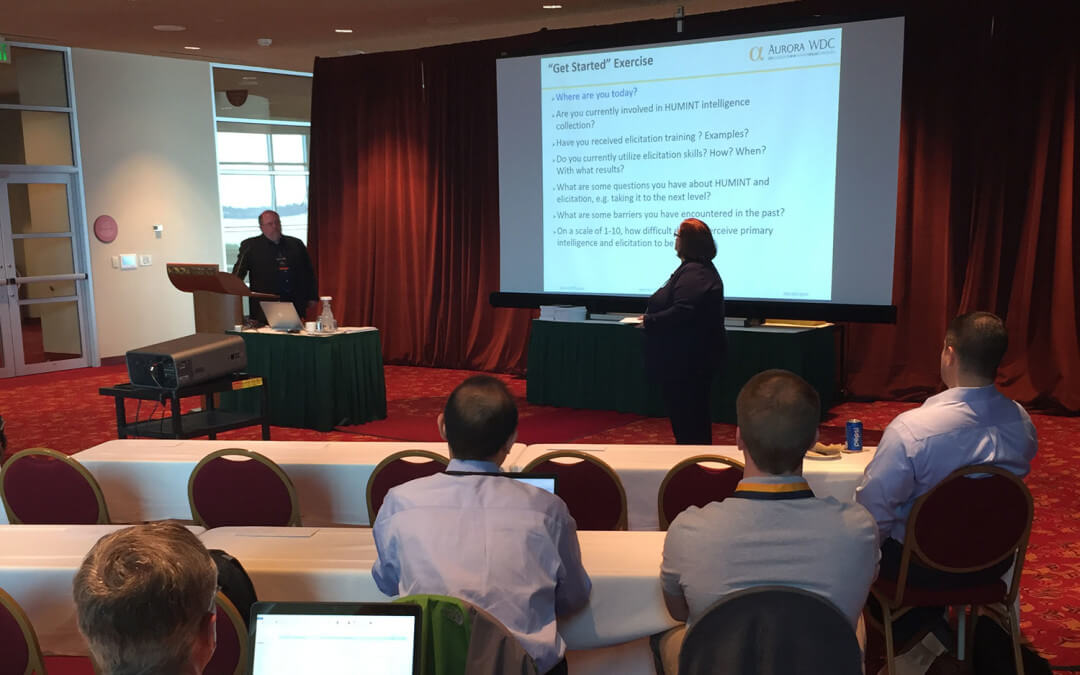Kicking things off at RECONVERGE:G2 on Tuesday, April 19 were Aurora WDC’s John Thomson and elicitation expert xxxxxx xxxxxx who shared their experiences and insight in the art and science of elicitation—ways to gather information from a primary source without making direct inquiries.
What is elicitation?
This conversational technique collects primary intelligence using tactics like word repetition, false statements to prompt clarifications, and other methodologies that solicit data in a way that does not reveal any specific information is of importance.
Further, this technique facilitates talks in which a conversational partner will share knowledge without assigning importance or great significance to an interaction.
An important aspect of elicitation is that it creates rapport with primary sources. It is a carefully planned, free-flowing conversation that does not alert others to your fact finding missions. Good elicitations will prompt information sharing without your conversational partner engaging the wary, ‘analytical self.’
Of course, barriers exist in accomplishing this objective. It is an interaction that requires tact, sensitivity, and awareness of the source’s comfort level throughout the conversation.
Questions make others defensive, and should be avoided. It is imperative the elicitor DOES NOT reveal what information is sought via direct questioning. Meandering, natural conversation will be more productive as it reveals insights interrogators will not uncover with targeted inquiries.
Can we “talk the talk”?
Discussing the elicitation process is one thing; practicing it is another! Two in-session exercises allowed participants to directly experience the joys, challenges, discomforts, irritation, and thrills of elicitation.
Attendees practiced knocking down conversational walls and building trust and confidence via the first in-session challenge during which participants were asked to discover 2-3 things about an unknown partner. This process required developing rapport by sharing personal observations and stories, incorporating neutral tones of voice, discovering commonalities, and establishing an environment of mutual sharing and interest to engage conversation.
The second exercise required partners solicit very specific pieces of information—like the partner’s birthday. A bit more of a challenge for conference attendees!
CI professionals need to learn to practice elicitation techniques at a variety of venues: trade shows, conferences and meetings may be more obvious sources for elicitation conversations. But it is important to “think outside the box” and also consider that places like golf courses, coffee shops, inside one’s own company, airplanes, restaurants are all great places to gather information as others are not likely to expect such locales as formal information collecting venues.
Do you know who you need to talk to?
Customers, suppliers, partners, distribution channels, industry leaders, speakers, inventors, journalists, regulators, consultants, and others are all potential elicitation sources. Consider who might hold the key to unlock needed information; it may not be who you might expect. Expand your horizons!
How do you plan the conversation?
Initial considerations are important. What do you have in common with these sources? What do they like to do for fun? What do you want to accomplish throughout the conversation? What motivates your source? What is their background, what are their values, what are their experiences?
The “Conversational Hourglass” is a way to visualize and plan the conversation to occur. Initially, the elicitor will discuss very broad topics, and through the talk, a narrowing of focus occurs. Direct statements instead of questions will be offered by the elicitor, as he or she continues to observe body language and monitor the comfort level of conversational partner.
The Hourglass talk concludes with a broad summation of topics such that the source does not view elicitor as a threat, and in fact, views the elicitor instead as a friendly, engaging conversationalist.
In designing an elicitation conversation, know that people will recall the beginning and end of it; middle parts of conversation are not top of mind. “Macro topics” introduce and conclude the talk which “micro topics”—the targeted area of interest, comprises the center of the chat.
We all have tendencies and motivations
Understanding that everyone has certain basic psychological needs and tendencies will facilitate good elicitation as we monitor these tendencies in others and take advantage of them to encourage information sharing.
There are inherent human tendencies that bear consideration;
- Urge to correct others;
- Desire to be recognized;
- An inability to keep secrets;
- Underestimating the value of information;
- Tendency to gossip;
- Urge to complain;
- Habits to teach and advise;
- Emotional indiscretion;
- A desire to share confidences and show off;
- Natural curiosity; and
- A tendency to discuss things that are not of direct concern.
Conversational methods are fruitful
Know how to gain information via incorporating conversational methods that facilitate information sharing. These tactics will prompt exchange:
- Flattery;
- Need to educate;
- Silence;
- Expression of mutual interest;
- Naïve mentality;
- An opposing stand;
- Provocative statements;
- An unbelievable attitude.
Practice makes perfect!
HUMINT/Elicitation requires a good deal of practice and experience. Elicitors must develop their own “secret sauce” in carrying out the conversation; a unique manner with which they feel comfortable and become effective.
Further, another important objective in elicitation is to create a relationship with the source such that they will hope to talk again in the future.
The pinnacle of good elicitation technique is developing a center of trust, rapport, reassurance, and approachability.
After this RECONVERGE:G2 workshop, we now know how to ‘talk the talk.’
And, we’ve learned when we ‘talk the talk,’ we don’t let them walk!
